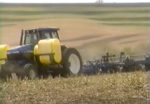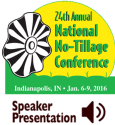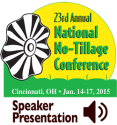Advertise Follow Us
Items Tagged with 'Marion calmer'
ARTICLES
2023 National Strip-Tillage Conference Delivers Moneymaking Insights
From Farmer to Innovator, Marion Calmer Paved the Way with Narrow Row Corn & the Tools to Harvest it
Read More10 Tips for Managing Residue Both During and After Harvest
Cutting-Edge No-Till Practices on Display in the Circle City
Big Crowd for No-Till Learning at NNTC’s Inaugural Visit to Louisville
Combining Settings to Manage No-Till Residue and Harvest Top Yields
PRODUCTS
How to Manage Corn Residue While Keeping it From Leaving Your Fields - Marion Calmer - NNTC 2016 Presentation - MP3 Download
Managing corn residue without it leaving your no-till fields is becoming a challenging task from the time of fall harvest to next year’s crop canopy. Because managing corn residue starts at harvest, in this presentation Marion Calmer discusses the mechanical impact that chopping corn heads, different styles of stalk rolls, stubble stompers and vertical tillage have on planting down pressure, clean seed trenches and how residue flows through planters. The western Illinois no-tiller also reviews the pros and cons of sizing corn residue, along with the economic impact it has on soil temperatures, soil moisture, earthworm populations, nutrient release, nitrogen tie-up and, ultimately, yield response.
ViewImprove Your Chances of Raising Profitable No-Till Corn, Soybeans - Marion Calmer - NNTC 2016 Presentation - MP3 Download
When considering the ways of improving his chances of raising profitable no-tilled corn and soybeans, Marion Calmer, a veteran no-tiller from western Illinois, relies heavily on his 31 years of independent on-farm research. As the president of Calmer’s Agronomic Research Center, he’s learned that the highest yield isn’t always the most profitable, so he makes decisions regarding inputs based on facts and financial sense. In this presentation, Calmer talks about his target of a minimum 35% return on investment for his farm when calculating input costs, and also discusses the yield impact and economic implications that accompany increasing populations, fertilizer inputs, row spacing and the lack of tillage.
ViewCombine Settings To Manage No-Till Residue, Harvest Top Yields - Marion Calmer - NNTC 2015 Presentation - MP3 Download
Marion Calmer takes corn harvest seriously. The no-tiller from Alpha, Ill., knows a properly adjusted combine will allow him to harvest every kernel possible, but he needs to process residue so he can no-till next year’s crop with limited interference from last year’s trash.
ViewWhy Ultra-Narrow-Row Corn Should Be In Your No-Till System - Marion Calmer - NNTC 2015 Presentation - MP3 Download
For 30 years, Marion Calmer has studied the impact on yields of no-tilling corn in ultra-narrow rows. The Alpha, Ill., no-tiller became so convinced at the benefits that he designed his own corn head to harvest 15-inch rows.
View

.png?height=125&t=1692819765&width=150)













